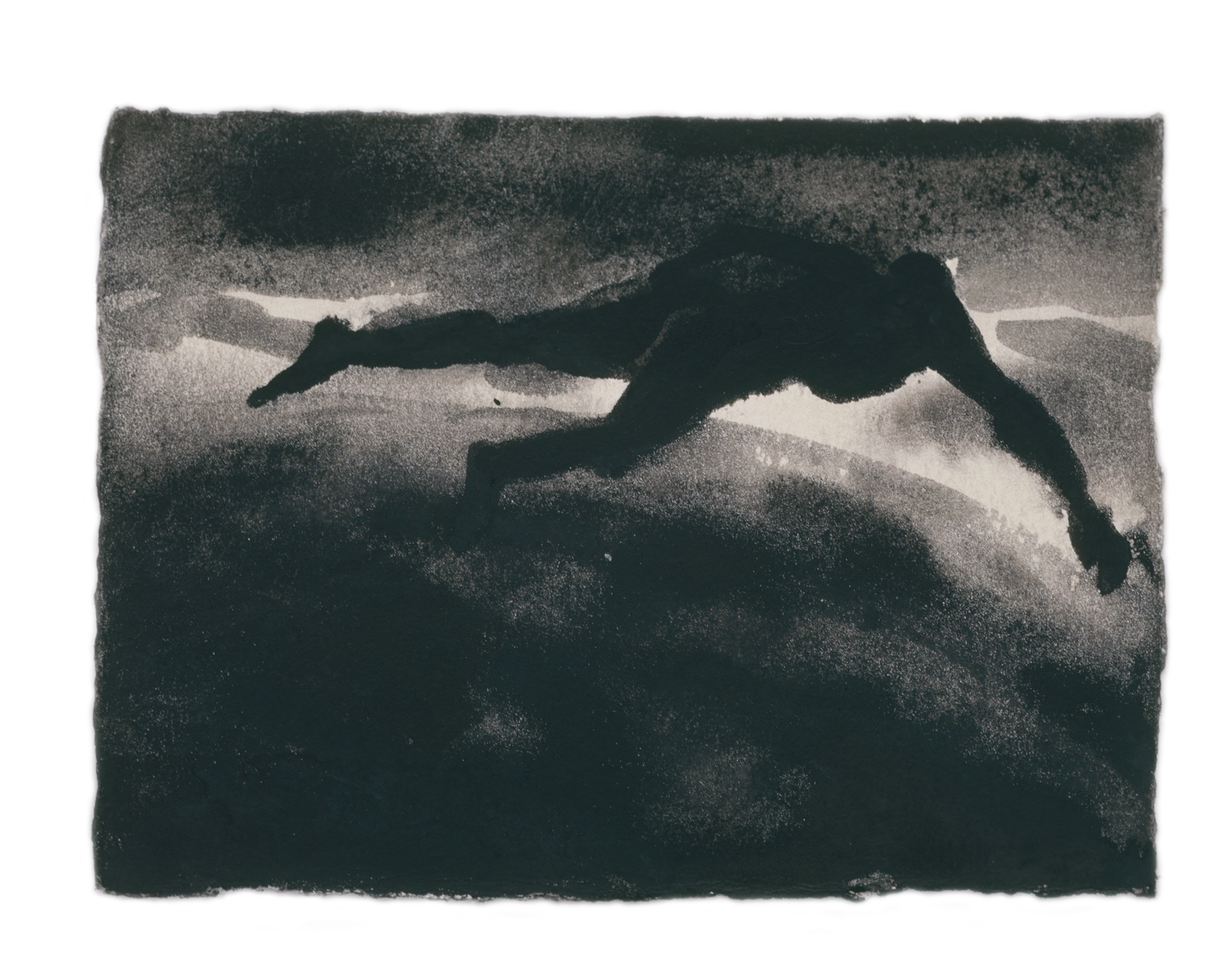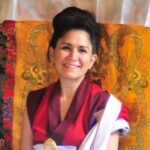There is a legend of a female master, Machik Jobum, who lived sometime in the eleventh to twelfth century. After experiencing severe illness, her father taught her the Six Dharmas (Tibetan: Naro Chodruk), a series of meditations for accomplishing swift awakening. Practicing these meditations, she became a great adept and attained mastery over her body and mind. Machik Jobum had accumulated a heavy burden of negative karma due to a difficult past in which she had committed murder using black magic. However, the Six Dharmas were a remedy for her, providing a path to healing and redemption. Jobum’s story is recounted in Tibetan histories such as The Blue Annals and in Tāranātha’s history of the Kalachakra. It is a reminder that although this system is composed of advanced esoteric practices, they can be performed even while feeble, sick, or dying. The great teacher, the Third Karmapa Rangjung Dorje (1284–1339), said one of these meditations can even be done by lazy people.
Here, I will offer a glimpse into the history of these practices, their practice and purpose, and share notes on how you could apply this knowledge in your life.
In brief, the Six Dharmas are a system of meditations for the day, the night, and the time of death, according to Rangjung Dorje, who explained this in his Profound Six Dharmas of Naro. The two meditations to be done during the day are tummo and illusory body, the two meditations to be done at night are dream yoga and clear light meditation, and finally, the two meditations for the time of death are called bardo and phowa. Bardo, in this case, emphasizes the liminal states in between death and rebirth, and phowa refers to the transference of consciousness at the time of death.
The six practices are a set of meditations that involve reexperiencing the mind and material body through somatic, sonic, neurocognitive, and visualized techniques. They emphasize experiences of illusion, dissolution, and emptiness. Whereas ordinary mind has a tendency to steer away from dissolution, these meditations explore it, leaning into liminality as a gateway to natural freedom. However, it is noteworthy that in this system that emphasizes emptiness, the quality of embodiment is crucial as well. All six practices center on utilizing events that happen in bodies. I was surprised to find that the Third Karmapa Rangjung Dorje’s explanation of the Six Dharmas centers the body so much that it even begins with an explanation of embryology! He painstakingly describes the emergence of a material body that is both connected to defilement and simultaneously serves as the landscape of liberation. According to Rangjung Dorje, it is this domain, embodied life, one prone to delusions, where there is a tendency to concretize things. The tendency to grasp, cling, and reify self is the catalyst for all manner of suffering. But the good news is that this grasping is the ailment for which the Six Dharmas are the ideal remedy.

Origins of the Lineage
Although every one of these practices was drawn from esoteric tantric traditions of India and Nepal, each of the six meditations also exists on its own or within other sets of Tibetan esoteric systems. Tibetan meditation systems often work in sets, with a set curriculum that moves from one kind of meditation to another. The origins of this sequence are usually attributed to the legendary tenth-century Indian master, Naropa. After a confrontation with a wild, elderly dakini, Naropa left behind his life as he knew it to go on a journey to find his teacher. His story raises eyebrows in the current context because it involved being subjected to deliberate hardships by his teacher, including psychological tests requiring supernatural feats. He is portrayed as having had an extreme, devoted endurance, which allowed him to awaken in the midst of these trials.
Naropa was said to have gathered the Six Dharmas in India and taught them to his Tibetan disciple Marpa. Marpa wrote them down and, in turn, taught Milarepa, the famous Tibetan yogi who is the best voice to introduce the first of the Six Dharmas. His “Song of the Snow Ranges” recounts tummo in vivid detail:
The snow fell big as bags of wool,
fell like birds flying in the sky,
fell like a whirling swarm of bees.
Flakes fell small as a spindle’s wheel,
fell as tiny as bean seed,
fell like tufts of cotton.
The snowfall was beyond all measure.
Snow covered all the mountain and even touched the sky,
falling through the bushes and weighing down the trees…
In this great disaster I remained in utter solitude.
The falling snow in the year’s-end blizzard fought me,
the cotton-clad, high on Snow Mountain.
I fought it as it fell upon me until it turned to drizzle.
I conquered the raging winds, subduing them to silent rest.
The cotton cloth I wore was like a burning brand.
The struggle was of life and death,
As when giants wrestle and sabers clash.
I, the competent Yogi, was victorious!
I set a model for all Buddhists,
An example for all great yogis.
This is a poem invoking the yogic heroism of tummo. Milarepa describes an unforgettable sight of yogins who would purposely sit on Himalayan glaciers and snowpacks wearing nothing but a wet cotton cloth in subzero temperatures. Through tummo meditation, they would generate inner fire, dry the wet cloth, and melt ice and snow, demonstrating mastery of the body and self-reliance. Studies of tummo have verified through EEG measurements that the practice can reliably and significantly increase body temperature. Tummo meditation also elicits blissful states by balancing left- and right-side vital bodily energies and redirecting them into the central channel of subtle physiology. That is followed by breath control and a hydraulic process in which visualized syllables, heat, and bliss drops cause a flow of energy to move, making states of nondual experience accessible. In some sets of the Six Dharmas, these tummo attainments are then stabilized by Karmamudra, sexual yoga, with an imaginary or actual consort.
Niguma and Other Masters
Even though the Six Dharmas are often credited to forefathers of the Kagyu lineages, especially Naropa, Marpa, and Milarepa, this system came to be practiced pervasively throughout Tibetan Buddhism. Indeed, these meditations served as the core techniques of awakening for some of the most accomplished Buddhist masters in Tibet. As such, it is another one of so many examples of interlineal cross-pollination that characterizes the varied manifestations of Tibetan Buddhism. The great fourteenth-century philosopher-yogi of the Nyingma tradition, Longchenpa (1308–1363) is one example. He learned the Six Dharmas when he was twelve and then again later from the Third Karmapa Rangjung Dorje. He even composed a text about them called The Total Refinement of Utter Lucidity; A Condensation of the Six Yogas of Naropa. Likewise, Tsongkhapa (1357–1419), great forefather of the Geluk lineage, wrote one of the most important commentaries to the praxis. It should not be surprising then that within Tibetan Buddhism, where diversity is the rule, not the exception, the Six Dharmas system appears within each lineage in varying ways with alternative lists as to what counted as the Six.
Here we have discussed at least three of the most important luminaries of Tibetan Buddhism as Six Dharmas practitioners; however, less well-known figures such as Jobum and women whose names we will never know were also crucial links in the chain of transmission.
The tendency to grasp, cling, and reify self is the catalyst for all manner of suffering. But the good news is that this grasping is the ailment for which the Six Dharmas are the ideal remedy.
For instance, another parallel lineage of these techniques is the Six Dharmas of Niguma. Niguma is considered a female master who lived at the same time as Naropa, in the tenth to eleventh century. Although having substantial overlap with the content of the Six Dharmas of Naropa, Niguma’s system is recognized as separate in an important early Tibetan history, The Blue Annals (fifteenth century). There is little known about Niguma, and the evidence is mixed on the question of what her relationship with Naropa was. She has been sometimes considered the sister of Naropa, such as in The Blue Annals. She is also sometimes identified by scholars as the consort of Naropa based on ambiguous terms, the paucity of contemporaneous information, and assumptions made in later sources.
It is in Niguma’s teaching that the flavor of emptiness that permeates the Six Dharmas is most palpable. She tells her student, “If you meditate on the illusion-like nature of illusion-like phenomena, the illusion-like buddhahood will occur.” Such instructions have profound implications for a devout Buddhist, who in their journey to understanding reality, must also regard the Buddhist teachings and the result of the Buddhist path as illusion-like. It radically underscores that there is nothing that can be concretized.
This directly relates to illusory body meditation, one of the Six Dharmas, a practice that Third Karmapa Rangjung Dorje said even a beginner can try, though it is impossible to stabilize if one confuses the view of emptiness with nihilism. Illusory body meditation involves training to notice the illusory quality in everything that appears in waking life, dreams, and death. The Six Dharmas of Niguma describes the illusory body practice as seeing everything as the deity’s form of empty appearance, thus it is a continuation of deity yoga. Sometimes the practice involves looking at oneself in the mirror and contemplating that the image one sees is empty. These methods are a direct application of the view of Vajrayana, that the world we witness is not what it seems. It is not as concrete, separate, or permanent as we assume it to be. Instead, it is empty of those qualities and partakes of an illusion-like nature. Embracing this awareness leads to natural wisdom.
Practices for Night & Death
Dream yoga is the next of the six in Rangjung Dorje’s list. Despite the name, it involves techniques when falling asleep, sleeping, dreaming, and waking. Dream yoga methods promote lucid dreaming, doing virtue and contemplative practices in one’s dream, and thereby greatly magnifying the merit of these actions. The use of visualized syllables when one falls asleep and wakes up are important aids to the practice, but crucial too is recognizing “I am dreaming” while one is awake. This creates a habit of recognizing the dream-like experience that will facilitate lucid dreaming in sleep, while also awakening one to the dream-like, illusory nature of reality while awake.
The next practice, clear light, is only experienced by advanced meditators who have stabilized nonconceptual awareness and can directly recognize the nature of mind because they are already familiar with it from a lifetime of practice. It is a state accessible before dream and just after death, but there are various techniques to prime oneself for it. “Clear light” refers to a reference-less state, like the sky, not experienced from the standpoint of a “self.” As such, it is a direct experience of emptiness. It can also be practiced as an exercise during meditation through a typical completion-stage visualization in which one sees oneself as the yidam deity and then sees oneself and the world dissolving into clear light.
Of the two practices for dying, one is phowa, or transference. All the other practices named here support phowa, which is a practice for achieving an ideal death by moving one’s mental body out of one’s physical body at death. Yogis train to exit through the crown of the head for an ideal rebirth or for liberation at the moment of death. Great lamas can also do this practice for others. In times past, they were believed to be able to even move consciousness from one body to another, such as in the case of the legend of Marpa, who, when his son was dying in a horse accident, transferred the son’s consciousness into a pigeon.
Last is bardo practice. It combines methods for dying, death, and post-death, as well as practicing in the bardo of this life, the liminal state between birth and death. Fear is unnecessary for those familiar with the nature of mind. In that case, death can also be an opportunity for enlightenment. In a sense, from the first moment of learning to meditate, learning to let go of thoughts in basic calm abiding (Tibetan: zhine) meditation, one is training for the profound letting go that culminates in letting go of the body and of this life. At the time of death, one may be able to recognize the clear light from having stabilized in nonconceptual awareness. If not, then in post-death, a mental body arises, and one sees everything that arises as the appearances of one’s own mind, just like in illusory body and deity yoga.
Applying the Practice
Yogic feats are meaningless without kindness. This is why, depending on the lineage, these are practices that are taught after completing preliminaries, such as cultivating the compassionate, altruistic, enlightened intent in Mahayana training and/or completing tantric preliminary practices, called ngondro. Ngondro lays the ideal psychological groundwork of confidence that makes it possible to learn and progress in liminal states without panicking. Following ngondro is initiation into a generation stage meditation, such as Chakrasamvara meditation. This will often come with initiation into the Six Dharmas as the corresponding completion-stage meditation. There is initiation required to enter into any of these practices,
which underscores the Vajrayana prioritization of relationships, ritual, and lineage.
In the meantime, learning about the Six Dharmas in the following articles offers abundant applicable lessons for any reader. The first benefit is that it unravels the assumptions about what “meditation” means, revealing the dynamic, sonic, visualized, somatic, psychological, and even interpersonal exercises that all fall under this term in Buddhism. So, in that sense, these pages open up a world of possibilities, a reimagining of meditation, and an inspiring invitation into the array of contemplative practices available in Vajrayana. Moreover, another benefit of reading this issue is that descriptions of the methods require explanations of key concepts of tantric theory. These are principles that one must become familiar with in order to cultivate a liberated mind through Vajrayana methods.

